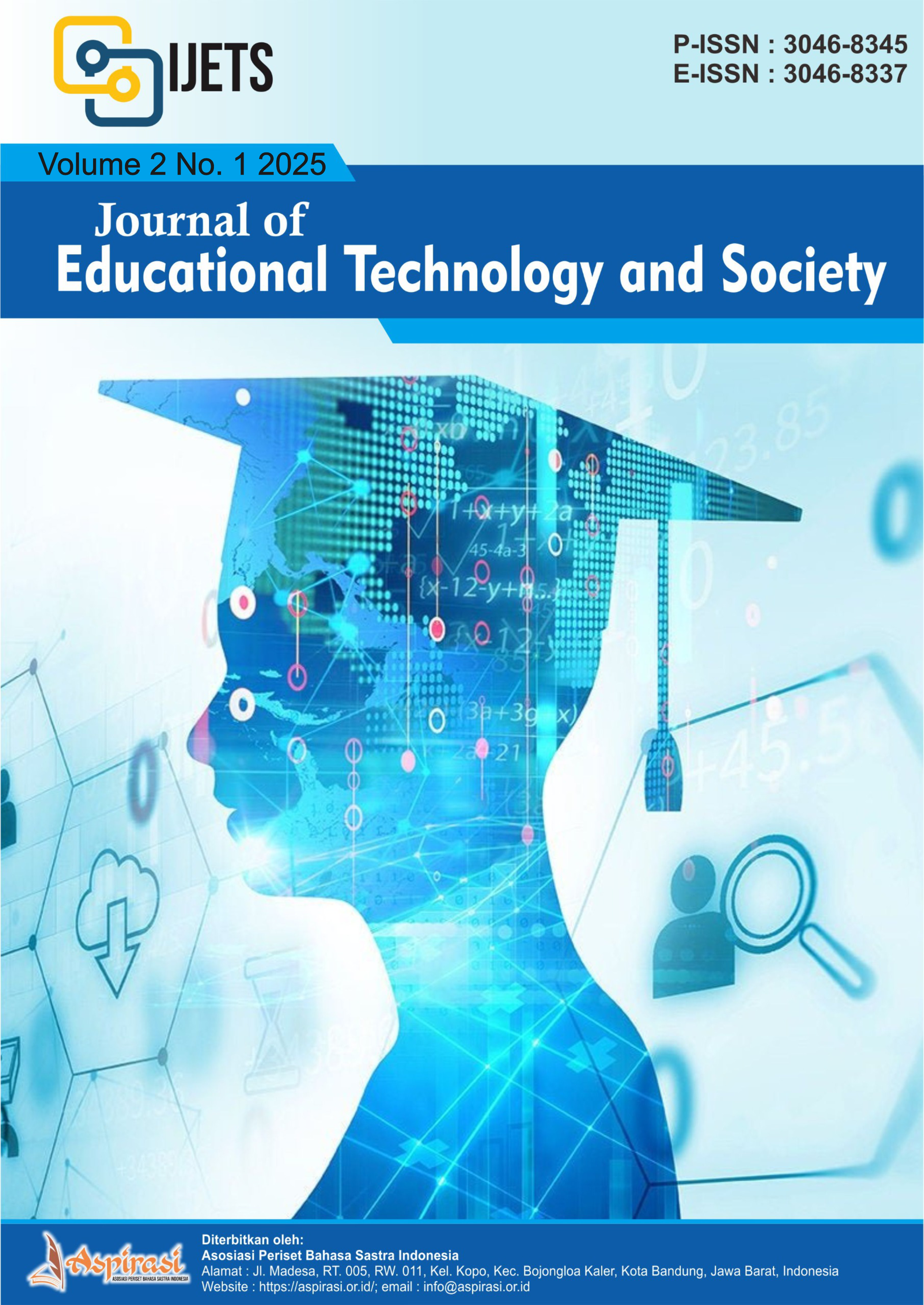Integration of Digital Technology in English Language Learning in Elementary Schools : Trends, Challenges, and Opportunities
DOI:
https://doi.org/10.61132/ijets.v2i1.238Keywords:
Digital Technology, English Language Learning, Primary Schools, Teaching ChallengesAbstract
This study explores the integration of digital technology in English language learning in primary schools, focusing on the trends, challenges, and opportunities it presents. The primary objective is to identify the current trends in the use of digital technology in English language instruction, examine the challenges faced by educators and students in its implementation, and assess the potential opportunities for enhancing the quality of learning. A Systematic Literature Review (SLR) method was used to gather and analyze relevant studies published over the last decade. The findings reveal that digital technology has significantly impacted teaching and learning by providing broader access to educational resources and enabling more interactive, engaging, and student-centered learning experiences. However, challenges such as infrastructure limitations, access gaps, and technical skills remain barriers to effective implementation. The study also identifies key opportunities for improving teacher training, expanding access to materials, and leveraging interactive platforms to enhance English language acquisition. The implications of these findings suggest that digital technology, when appropriately integrated, can greatly improve the quality of English education in primary schools. Future research should focus on addressing the identified challenges and exploring more inclusive technological solutions.
References
Anderson, C. A., Adachi, P., & Shi, J. (2017). The effects of violent video games on aggressive behavior: A meta-analysis of the scientific literature . Journal of Personality and Social Psychology, 103(4), 524-536. https://doi.org/10.1037/pspi0000023
Avgerinou, M.D., & Sarris, A. (2018). The challenges of integrating digital technology into education. Journal of Educational Technology & Society, 21(1), 51-63. https://doi.org/10.1109/jetset.2018.00014
Bax, S. (2016). Language learning and technology: A critical review of research. Cambridge University Press.
Chik, A. (2014). Digital media in foreign language learning and teaching. In S. Bax & D.F. Halverson (Eds.), Language learning and technology: A critical review of research (pp. 89-103). Cambridge University Press.
Coyle, D., Hood, P., & Marsh, D. (2010). CLIL: Content and language integrated learning . Cambridge University Press.
Ertmer, P. A., & Ottenbreit-Leftwich, A. T. (2010). Teacher technology change: How knowledge, confidence, beliefs, and culture interact. Journal of Research on Technology in Education, 42(3), 255-284. https://doi.org/10.1080/15391523.2010.10782551
Garrison, D. R., & Vaughan, N. D. (2013). Blended learning in higher education: Framework, principles, and guidelines . John Wiley & Sons.
Gee, J. P. (2017). What video games have to teach us about learning and literacy. Computers in Entertainment (CIE), 1(1), 20-26. https://doi.org/10.1145/946000.946010
Hsu, Y.S. (2017). Barriers and challenges in integrating technology into teaching. Educational Technology Research and Development, 65(5), 1155-1170. https://doi.org/10.1007/s11423-017-9526-7
Kitchenham, B. (2004). Procedures for performing systematic reviews. Technical Report 0400011T. Department of Computer Science, Keele University . Retrieved from https://doi.org/10.1109/SER.2004.1315394
Li, X. (2017). Language learning through mobile devices: An overview and analysis . Journal of Educational Technology Development and Exchange (JETDE), 10(1), 1-15. https://doi.org/10.18785/jetde.1001.01
Lin, C. C., & Lan, Y. J. (2015). The effects of a mobile-assisted language learning system on learners' English speaking and listening abilities. Educational Technology & Society, 18(2), 79-91. https://doi.org/10.1109/jets.2015.00018
Liu, M., Moore, Z., Graham, L., & Lee, S. (2016). A study of online learning in higher education: A review of the literature. Educational Technology & Society, 19(3), 52-63. https://doi.org/10.1109/jets.2016.00028
Mayer, R.E. (2009). Multimedia learning. Cambridge University Press.
Mishra, P., & Koehler, M. J. (2006). Technological pedagogical content knowledge: A framework for teacher knowledge. Teachers College Record, 108(6), 1017-1054. https://doi.org/10.1111/j.1467-9620.2006.00684.x
Mouza, C. (2018). Learning with technology: The impact of digital tools on students' writing and engagement . Journal of Educational Psychology, 110(4), 551-562. https://doi.org/10.1037/edu0000198
O'Bannon, B. W., & Thomas, K. L. (2015). Preservice teachers' integration of technology in K-12 classrooms: A review of the literature. Journal of Research on Technology in Education, 47(2), 161-174. https://doi.org/10.1080/15391523.2015.1038740
Prensky, M. (2016). The world is changing, and so is education: The future of learning and technology. Educational Leadership, 73(4), 10-15.
Puentedura, R.R. (2014). SAMR: A transformational model for integrating technology in education. In Proceedings of the 2014 Educational Technology Conference (pp. 45-56). International Society for Technology in Education.
Selwyn, N. (2016). Education and technology: Key issues and debates. Bloomsbury Publishing.
Suh, S., Kim, S., & Kim, J. (2017). Using game-based learning for English as a foreign language. Journal of Educational Technology, 9(3), 213-226. https://doi.org/10.1109/JET.2017.00123
Sung, Y.T., & Hwang, G.J. (2018). Effects of an augmented reality-based learning system on students' learning performance and motivation. Educational Technology & Society, 21(2), 69-82. https://doi.org/10.1109/jets.2018.00045
Surjono, H. (2019). The role of teachers in the integration of digital technology in elementary schools. Journal of Technology and Vocational Education, 14(2), 132-142.
Tondeur, J., van Braak, J., & Ertmer, P. A. (2016). Understanding the relationship between teachers' pedagogical beliefs and technology use in education: A systematic review of the literature. Computers & Education, 59(3), 1345-1359. https://doi.org/10.1016/j.compedu.2012.04.011
Tranfield, D., Denyer, D., & Smart, P. (2003). Towards a methodology for developing evidence‐informed management knowledge by means of systematic review. British Journal of Management, 14 (3), 207-222. https://doi.org/10.1111/1467-8551.00375
Vygotsky, L. S. (1978). Mind in society: The development of higher psychological processes. Harvard University Press.
Wang, H., Chen, L., & Yu, S. (2017). The impact of digital learning tools on students' academic performance. Journal of Educational Computing Research, 55(5), 599-618. https://doi.org/10.1177/0735633117717889
Warschauer, M., & Healey, D. (2017). Technology and social inclusion: Rethinking the digital divide. MIT Press.
Warschauer, M., & Matuchniak, T. (2010). New technology and digital worlds: Analyzing evidence of equity in access, use, and outcomes. Review of Research in Education, 34(1), 179-225. https://doi.org/10.3102/0034654313490709
Winke, P., Gass, S. M., & Myles, F. (2013). The role of technology in language learning. The Modern Language Journal, 97(2), 309-328. https://doi.org/10.1111/j.1540-4781.2013.12004.x
Downloads
Published
How to Cite
Issue
Section
License
Copyright (c) 2025 International Journal of Educational Technology and Society

This work is licensed under a Creative Commons Attribution-ShareAlike 4.0 International License.





